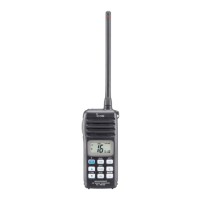4 - 1
4-1 RECEIVER CIRCUITS
4-1-1 ANTENNA SWITCHING CIRCUIT
(MAIN UNIT)
The antenna switching circuit functions as a low-pass filter
while receiving and as resonator circuit while transmitting.
The circuit does not allow transmit signals to enter receiver
circuits.
Received signals from the antenna connector pass through
the low-pass filter (L81, L82, C83–C86, C89) and antenna
switching circuit (D52, D90). The filtered signals are then
applied to the RF amplifier circuit (Q90).
4-1-2 RF AND 1ST MIXER CIRCUITS (MAIN UNIT)
The 1st mixer circuit converts the received signals to a fixed
frequency of the 1st IF signal with a PLL output frequency.
By changing the PLL frequency, only the desired frequency
will be passed through a pair of crystal filters at the next
stage of the 1st mixer.
The signals from the antenna switching circuit are passed
through the tunable bandpass filter (D92) and amplified at
the RF amplifier (Q90). The amplified signals are passed
through another tunable bandpass filter (D130), and then
applied to the 1st mixer circuit (Q150).
The filtered signals are mixed at the 1st mixer (Q150) with a
1st LO signal coming from the PLL circuit to produce a 21.7
MHz 1st IF signal. The 1st IF signal is passed through two
crystal filters (FI150, FI151) and is then amplified at the IF
amplifier (Q151).
4-1-3 2ND IF AND DEMODULATOR CIRCUITS
(MAIN UNIT)
The 2nd mixer circuit converts the 1st IF signal to a 2nd IF
signal. A double conversion superheterodyne system (which
converts receive signal twice) improves the image rejection
and obtain stable receiver gain.
The 1st IF signal is applied to a 2nd mixer section of the FM
IF IC (IC170, pin 16). The signal is then mixed with a 2nd LO
signal for conversion into a 450 kHz 2nd IF signal.
IC170 contains the 2nd mixer, limiter amplifier, quadrature
detector and active filter circuits. A 21.25 MHz 2nd LO signal
is produced at the PLL circuit using the reference frequency.
The 2nd IF signal from the 2nd mixer (IC170, pin 3) passes
through ceramic filters (FI170) to remove unwanted hetero-
dyne frequencies. It is then amplified at the limiter amplifier
section (IC170, pin 5) and applied to the quadrature detec-
tor section (IC170, pins 10 and 11) to demodulate the 2nd IF
signal into AF signals.
4-1-4 AF CIRCUIT (MAIN UNIT)
AF signals from the FM IF IC (IC170, pin 9) are fed to the
analog switch (IC260).
The AF signals (detected signals) are passed through the
analog switch (IC260, pins 2 and 1) and are then applied to
the active low-pass filter (IC200c, pin 9).
The filtered AF signals are applied to and adjusted audio
level at the D/A convertor (IC190, pin 24) to adjust ampli-
tude. The level controlled signals are passed through the AF
mute switch (Q280) which is controlled by “AFMS” signal
from the CPU (IC360, pin 47). The passed signals are
applied to the AF power amplifier (IC280, pin 4), and then
output to the internal speaker or [EXT SP] jack after being
passed through the de-emphasis circuit (R286, C285) to
obtain the –6 dB/octave frequency characteristics.

